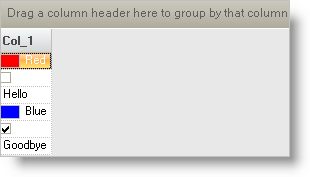Usually to accommodate for multiple data types, you will need a data model that has a property that can accommodate for multiple data types. The following code example shows a simple implementation using a DataTable:
Dim t As New DataTable
t.Columns.Add("Col_1", GetType(Object))
t.Rows.Add(New Object() {Color.Red})
t.Rows.Add(New Object() {False})
t.Rows.Add(New Object() {"Hello"})
t.Rows.Add(New Object() {Color.Blue})
t.Rows.Add(New Object() {True})
t.Rows.Add(New Object() {"Goodbye"})
DataTable t = new DataTable();
t.Columns.Add("Col_1", typeof(object));
t.Rows.Add(new object[] { Color.Red });
t.Rows.Add(new object[] { false });
t.Rows.Add(new object[] { "Hello" });
t.Rows.Add(new object[] { Color.Blue });
t.Rows.Add(new object[] { true });
t.Rows.Add(new object[] { "Goodbye" });
An appropriate event to test for and assign different editor types is the WinGrid’s InitializeRow event. This event will fire once for each WinGrid Row that is being rendered. The event arguments will expose each Row as it comes in through the event. Here is where you can perform your tests and depending on the results, you can assign different editors to the cells of interest.
The following code shows how the InitializeRow event is being handled in order to test the Data Type of a specific Cell Value and then assign the appropriate editor to that Cell:
Imports Infragistics.Win
Imports Infragistics.Win.UltraWinEditors
...
Private Sub UltraGrid1_InitializeRow( _
ByVal sender As System.Object, _
ByVal e As InitializeRowEventArgs) _
Handles UltraGrid1.InitializeRow
'Create the Settings Object:
Dim theSettings As New DefaultEditorOwnerSettings
'as well as the Editor Owner:
Dim theOwner As New DefaultEditorOwner(theSettings)
Dim theEditor As EmbeddableEditorBase = Nothing
Dim theValue As Object = e.Row.Cells(0).Value
'Create an appropriate editor based on the
'Value's Data Type:
If TypeOf theValue Is Boolean Then
theSettings.DataType = GetType(Boolean)
theEditor = New CheckEditor(theOwner)
ElseIf TypeOf theValue Is Color Then
theSettings.DataType = GetType(Color)
theEditor = New ColorPickerEditor(theOwner)
ElseIf TypeOf theValue Is String Then
theSettings.DataType = GetType(String)
theEditor = New EditorWithText(theOwner)
End If
'Assign it to the Cell.Editor
e.Row.Cells(0).Editor = theEditor
End Sub
using Infragistics.Win;
using Infragistics.Win.UltraWinEditors;
...
private void ultraGrid1_InitializeRow(
object sender,
Infragistics.Win.UltraWinGrid.InitializeRowEventArgs e)
{
//Create the Settings Object:
DefaultEditorOwnerSettings theSettings =
new DefaultEditorOwnerSettings();
//as well as the Editor Owner:
DefaultEditorOwner theOwner = new DefaultEditorOwner(theSettings);
EmbeddableEditorBase theEditor = null;
object theValue = e.Row.Cells[0].Value;
//Create an appropriate editor based on the
//Value's Data Type:
if (theValue is bool)
{
theSettings.DataType = typeof(bool);
theEditor = new CheckEditor(theOwner);
}
else if (theValue is Color)
{
theSettings.DataType = typeof(Color);
theEditor = new ColorPickerEditor(theOwner);
}
else if (theValue is string)
{
theSettings.DataType = typeof(string);
theEditor = new EditorWithText(theOwner);
}
//Assign it to the Cell.Editor
e.Row.Cells[0].Editor = theEditor;
}
As each Row is being initialized, Cell 0’s Value is being examined in order to determine its Data Type. If it is a Boolean, then we create a new instance of the CheckEditor and assign it to that Cell. If it is a Color, then we create a new instance of the Color Picker and assign it to that Cell. Finally if it is a String, we create a standard EditorWithText and assign it to that Cell. This can be elaborated to include more complex logic as well as diverse Data Types. When run, the grid will look similar to the following:
If you notice in the code, the class DefaultEditorOwnerSettings is being used. This is simply a class that contains property settings that will be applied to the various Editor Controls that it is associated with. The DefaultEditorOwnerSettings Class contains properties that allow you to configure the Mask characteristics, Formatting, Data Type, Minimum and Maximum Character Length as well as Minimum and Maximum Value. Whenever we assign editors on a Cell by Cell basis, we need to construct the Editors on a lower level much like we have shown in this example.
Now that you understand how to implement both Column and Cell level Editors, you can build a UI that can accommodate any of these use cases.

